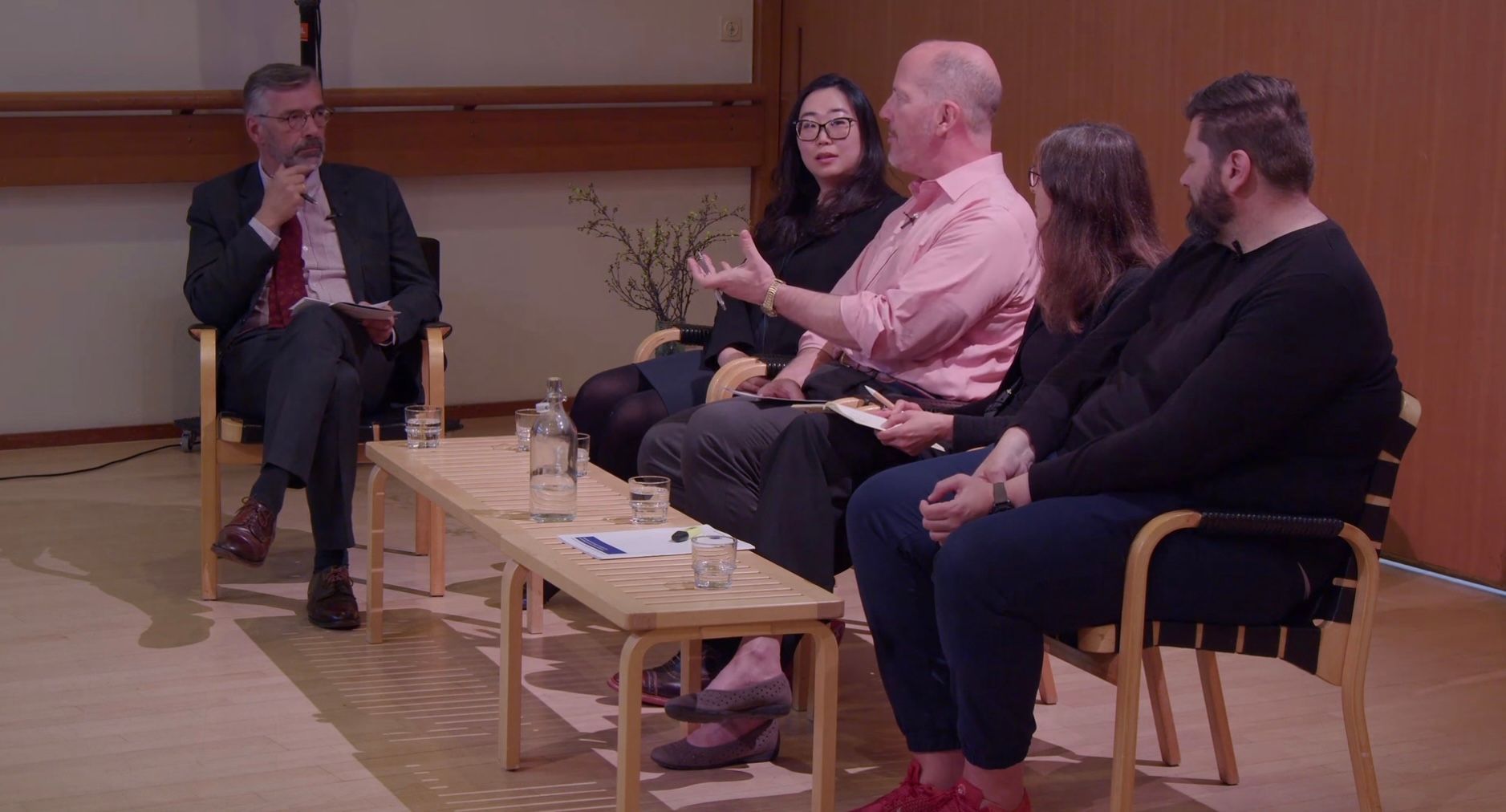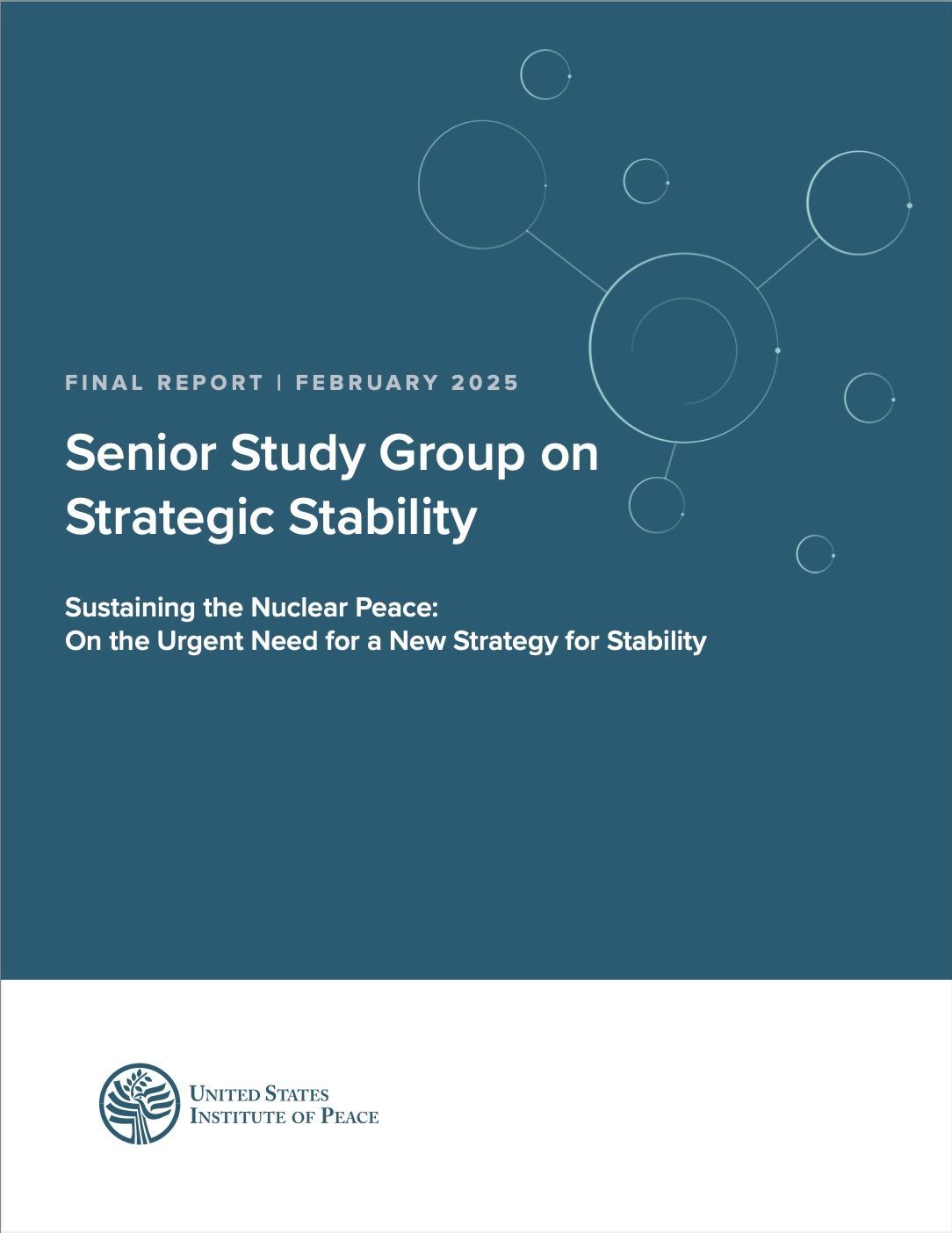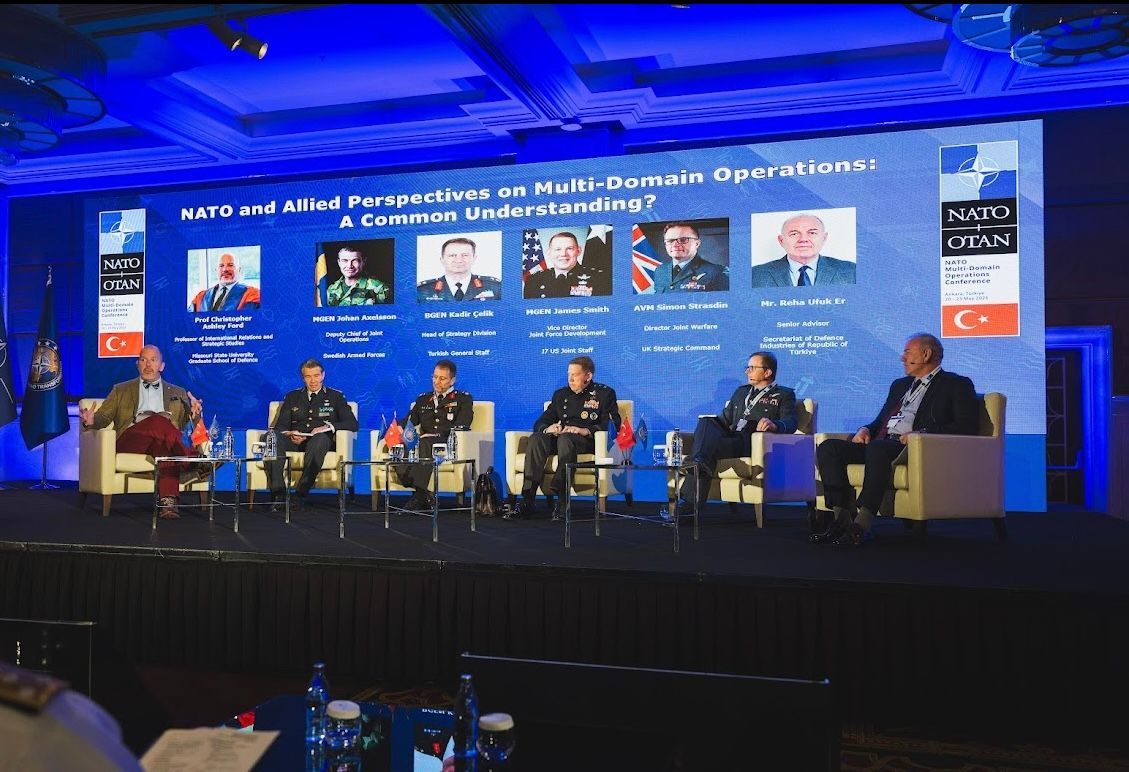Arms Control Challenges in Strategic Technology Competition
Below are the prepared remarks upon which Dr. Ford based some of his contributions on a panel on “Tech for War or Tech for Peace? Science, Innovation, and Emerging Technologies in a New Geopolitical Era” at a conference in Reykjavik, Iceland, on May 22, 2025, sponsored by the Arms Control Negotiation Academy (ACONA) and the Peace Research Institute Frankfurt (PRIF).

Good morning, everyone, and thanks for inviting me here to Reykjavik for this event. Thanks also to Christopher Daase, PRIF’s deputy director, for moderating our opening panel discussion today. Whatever I offer today will only be my personal opinion, of course, and won’t represent the views of anyone else, but I’m pleased to be able to offer a few tentative thoughts for you today.
As a way of trying to get your attention, let me first address the importance of science, innovation, and technology in strategic competition. (Spoiler alert: I think it’s very important.) After that, I’ll address what changing technology might mean for the future of arms control verification and compliance.
Technology in Strategic Competition
I think it’s pretty clear now that key emerging technology areas are becoming increasingly important to (and in) strategic competition, especially in the U.S.-China relationship Think, if you will, about Artificial Intelligence (AI), quantum computing, big data analytics, and bioengineering.
To be sure, the role of technology in such competition isn’t an entirely new phenomenon.
- Allied advantages in new technologies such as radar, machine-based cryptography, the proximity fuse, and of course the atom bomb, for example, played a significant role in determining the outcome of the last great global war. It was also pretty important that that the Nazis weren’t quite able to capitalize on some rather impressive new technologies that they developed in that conflict and that were going to be significant later (e.g., the jet engine, remote-guided bombs, drone vehicles, and ballistic missiles).
- Military-technological competition was obviously also a major part of the U.S.-Soviet rivalry during the Cold War – especially in aerospace, as epitomized by the Sputnik shock and the Space Race of the 1960s – just as the relative lack of military-technical competitors for the United States was a critical factor in creating geopolitical “unipolarity” for a generation after the fall of the Berlin Wall in 1989.
The centrality of technology in strategic competition, however, strikes me as being a fairly modern phenomenon. New technologies have given their possessor some degree of military or even geopolitical advantage throughout much of history, and powers have long tried to control access to technologies felt to provide such rewards, but the last few generations still seem special.
Access to iron mines, for instance, was at least part of strategic competition between powers in the Ancient Near East as the world shifted from the Bronze Age into the Iron Age. In their early, abortive foray into the New World, the Vikings also recognized how iron weapons gave them advantages over the Native American tribes they called Skraelings, and duly imposed what were basically national security export controls upon their settlements by forbidding trading such items with the natives.
Ancient China analogously tried to control the export of iron-wrought crossbow trigger mechanisms from flowing to the peoples to its West, even while seeking to preserve its own access to the fine cavalry horses that were apparently bred only out there. And when, in turn, the stirrup made its way out of Central Asia to Western Europe, it made possible the fearsome heavy armored cavalry of Europe’s medieval knights. Some historians, moreover, have described the domains of the Russian tsars in Central Asia, the Mughal Empire in South Asia, and the Qing Dynasty in China as being – in some sense – “gunpowder empires” as a result of their rulers’ ability to employ that technology in wars of imperial expansion against less well-equipped foes.
For most of history, however, technological change didn’t feel as central to strategic competition as it appears to have become in the modern world – a world in which competition in technology is quite explicitly a primary object of strategic rivalry. In today’s pervasively technologized world, there seems to be a widespread assumption that advantages in the latest technology translates directly and quickly into geopolitical power.
Indeed, this dynamic seems to be accelerating. Technology did not feel nearly so central, for instance – and indeed, arguably wasn’t really perceived as important at all – even as late as the Napoleonic Wars. By the end of the 19thCentury, however, Britain and Imperial Germany were engaged in a fierce technology-based competition as each worked furiously to out-build the other in the naval arms race of the Dreadnought era, while the United States and Japan were investing heavily in their own high-tech battleship fleets as they made their way onto the geopolitical stage as great powers. And the curve just seems to have been getting steeper ever since.
If you ask me, such assumptions about the centrality of technology in strategic competition are in some sense an outgrowth of the world’s experience with the Industrial Revolution of the late 18th and early 19th Century, and the era of European imperialism that it helped make possible. I think, at least, that this is very much the case when it comes to contemporary Chinese approaches to technology competition.
I’ve spoken and written about this elsewhere, so I won’t get into the details today, but it is worth remembering the degree to which technological innovations growing out of the Industrial Revolution came to give the European powers – and especially Britain, which could be said to have possessed “first-mover” position in that Revolution – huge advantages over other powers by the middle years of the 19th Century. In 1750, for instance, the Qing Dynasty in China was arguably a far more impressive and powerful kingdom than any of the ones in Western Europe, and indeed Western intellectuals such as the Enlightenment philosophes looked at what little they thought they knew of China with respect, awe, and some envy. By 1850, however, the Qing had already embarrassingly lost the first of a string of conflicts with Britain and the Europeans that Chinese nationalists have remembered ever since as the onset of their “Century of Humiliation.”
Asymmetrically-possessed improvements in technology were critical to this huge geopolitical shift. It was not just that advances in coal mining, iron smelting, the steam engine, factory-based production, railways, and the telegraph “supercharged” Europe’s early industrial economies. It was that such improvements also led to a “Revolution in Military Technology” (RMA) based in things such as steam powered armored warships, mass-produced and accurate rifled firearms with smokeless powder, and vastly improved artillery.
Modern Chinese leaders seem, in fact, to have built what is almost a whole theory of history around this. As Chinese Communist Party (CCP) officials including Xi Jinping seem to see it, the geopolitical history of the 19th, 20th, and early 21st Century was basically decided by whoever was fortunate enough to possess “first-mover” advantage in the Industrial Revolution of the time. As I have described, the First Industrial Revolution made the 19th Century “Britain’s century.” Thereafter, it was the United States that acquired pole position in a Second Industrial Revolution grounded in modern, mass industrial production, as well as in a Third Industrial Revolution based upon computers and Information Technology (IT). It was U.S. first-mover advantages in those Revolutions that made America the dominant global power in the 20thCentury and into the 21st.
In the CCP’s view of technological history, therefore, whomever has first-mover advantage in the Industrial Revolution of the day more or less gets to reshape the global order around itself. So when you hear CCP officials declare that they plan to use industrial and technology policy to seize the “commanding heights” of the Fourth Industrial Revolution that Xi Jinping has proclaimed is now dawning – one built upon Artificial Intelligence, big data analytics, quantum computing, and the like – you should not misunderstand what they are saying. They means to acquire for China the same sort of global role that Britain took upon itself in the 19th Century, and America in the 20th.
In this view, technological advantage isn’t just a “nice-to-have” element of strategic competition. To some extent, it’s actually the whole game. The point is certainly not just about making profits and winning market share in producing the coolest widgets for a world of eager consumers; it’s a world-historical question of who has global power.
And all this isn’t even counting the now apparently quite widespread belief that current progress toward ever-improving AI may before long produce an Artificial Superintelligence (ASI) – as discussed so interestingly a provocatively in a recent paper published by Daniel Kokotajlo and his colleagues at the AI Futures Project. I won’t even begin to speculate about that here, but it is worth noting that another recent paper by Dan Hendrycks, Eric Schmidt, and Alexandr Wongobserved recently that “[a] nation with sole possession of superintelligence might be as overwhelming [to its rivals] as the Conquistadors were to the Aztecs.” If that sounds to you like it’s a pretty compelling argument for a kind of ASI arms race, it may well be.
But whatever you make of the fraught question of ASI, I think it’s beyond argument that emerging technology has become of enormous importance in strategic competition.
Emerging Tech and Arms Control Verification and Compliance
So what should a group like ACONA make of this from the perspective of arms control?
I spoke last year at an event at the Center for Strategic and International Studies (CSIS) about the potential impact of new technologies on arms control. Rather than just recapitulating those remarks, however, I’ll focus today a bit more specifically upon the challenges of arms control verification and compliance – that is, of detecting when another party is doing things that seem inconsistent with an arms control treaty and making a formal compliance assessment about whether or not that activity indeed constitutes a violation.
On the positive side, it might be that some of the technologies we see emerging today might allow arms control verifiers important new insights into non-compliant activity that such a violator might wish to conceal. Quantum sensing, for instance – especially when combined with sophisticated data analytics and AI – might be able to peer through or work around adversary denial and deception (D&D) efforts, allowing some sorts of illegal activity to be detected far better than at present.
Such a revolution in transparency might well be rather bad news for strategic stability and deterrence as a whole, of course – such as if it opened a window into the depths of the seas that might finally allow adversaries to hold at risk each other’s hitherto survivable submarine-based second-strike ballistic missile deterrent capability. But merely from an arms control perspective, it might well be that such new technology would make the “verifier’s” task much easier, and the “concealer’s” task much harder, with an impact upon arms control verification possibilities as great as the advent of overhead satellite-based overhead reconnaissance (e.g., the CORONA spy satellite) had from the early 1960s, enabling subsequent U.S.-Soviet arms control to do a good deal of verification through what came to be known as “National Technical Means” (NTM).
(During the Obama Administration – when people still seemed to think that the explosion of ubiquitous, modern social media connectivity would be a good thing for the world rather than an all but unmitigated political, psychic, and sociological disaster – there was also a good deal of enthusiasm for the idea of enlisting an army of netizens to police their own governments’ compliance with arms control agreements. In today’s environment of pervasive online disinformation and conspiracy theorizing, however, people don’t really talk about that much anymore. I didn’t think it made a lot of sense to begin with, primarily because that kind of verification would work best only for the arms control parties you’d probably worry about least – that is, liberal democracies with free citizenries who have freedom of expression – and worst in the predatory authoritarian regimes historically most likely to break the rules. So I’ll leave that idea aside.)
On the whole, however, I worry that today’s environment of accelerating and technology-focused strategic competition – and the nature of the technologies that seem most “emergent” today – are likely to make arms control verification harder.
As suggested by our efforts during the First Trump Administration to explore new agreements with Russia and China, even in the realm of relatively traditional nuclear arms control, we are likely to need a whole suite of new verification approaches that don’t really exist yet. We were working then, for instance, upon the challenge of how to move beyond prior efforts simply to count and limit nuclear delivery systems – past approaches that dealt with actual nuclear warheads only indirectly and obliquely, through bomber counting rules and a limited sort of “spot-check” inspection protocol for ICBM load-out under the START agreement – into a new era of arms control that limited (and could verify) the total size of a party’s nuclear warhead stockpile. Because countries like Russia and China are pretty darn big, and individual nuclear warheads can be fairly small, this was a challenging task. We had ideas about how perhaps to do this in 2020, but I think this is still an area where the verification methodologies and technologies aren’t nearly where an arms controller would really want them to be.
I’m also aware of no good answer yet to the verification challenges presented by dual-capable ballistic and cruise missile systems that can swap nuclear warheads in and out with conventional warhead packages fairly easily. The arms control community seems so far largely to have ignored this problem from a verification perspective, notwithstanding the fact that the Russians and Chinese have fielded such things for years. That was probably a mistake, for such dual-capable systems may become increasingly important in future arms control diplomacy, especially if we in the United States also start to acquire them to counter our adversaries’ destabilizing current overmatch in theater-class nuclear systems.
The growing migration in military technology from “bespoke” military-specific systems to the much more widespread utilization of Commercial-off-the-Shelf (COTS) technology is also likely to create growing headaches for arms control verifiers, for that will likely to reduce the distinctiveness of military applications and the specificity of the technical weaponization “tells” that a verification regime might seek to detect. As the world discovered a quarter-century ago when efforts to negotiate a Biological Weapons Convention (BWC) Protocol collapsed, it can be all but impossible to design an effective verification regime for a type of weapon the essential facilitating technologies for which are already massively proliferated across the global civilian techno-economy. (If you wished to verify compliance with some kind of future arms control treaty on weaponized AI, for example, how would you do that in a world the private sector of which remained as effervescently and ubiquitously obsessed with commercial AI development and scaling as is ours today? I really have no idea.)
The increasing “software-ization” of military innovation is also likely to make life much harder for arms controllers, especially if one wished to move arms control more into the realm of non-nuclear arms. With Cold War strategic weapons, most of the things you might want to limit (e.g., the range, throw-weight, or re-entry vehicle capacity of an intercontinental missile) were comparatively easy to see, and the signatures of possessing them (e.g., digging big missile silos into the ground or launching SLBM-equipped submarines) were comparatively visible. (Even chemical warfare agent production in those days was approached on an industrial scale, with large, dedicated facilities that weren’t too hard to identify.) In the age of software, however – and especially with things like cyberspace capabilities and AI tools – the capabilities of a system that are the most militarily relevant, and hence of most interest to arms controllers, may lie only deep in the coding of a system’s computer brain.
Such a radical “interiorization” of relevant capability is likely to be hugely challenging, if not preclusive, for the verification community. Even if some kind of “inspection” protocol could technically be envisioned – which seems to me to be rather a stretch – the relevant details of code-related capabilities are surely not the sort of thing that anyone is going to let anyone else see.
Exposing the existence of a cyberspace “zero-day” exploit, for instance, is likely to destroy its utility as an exploit, while revealing AI model weights would in some sense be the equivalent of gifting the AI “weapon” to the inspector. In the AI context, moreover, even revealing details about one’s set of training data could open up possibilities for adversary data-“poisoning” of the sort that Russian cyber-spies are reportedly already attempting in the West. Good luck asking countries to sign up to those verification protocols!
I am not myself a technologist, but even to my eye this all suggests that strategic competition in advanced technologies is going to be a really challenging environment for arms control verifiers.
(Even) More Need for Compliance Assessment Integrity?
But that’s verification. What about compliance assessment – the “other half” of the arms control “verification and compliance” mission?
If things are going to be getting even harder for arms control verifiers in a future environment of rapid and transformative technological change, the increasing complexity and ambiguity of verification-relevant information – espeicially in a political environment many have lost their trust in institutions and people seem as willing to disbelieve the obvious as they are to believe the fantastical – is likely also to place strains upon compliance assessment In response to these strains, I would argue that it is crucial for arms control compliance analysts to maintain their intellectual integrity and moral courage.
A key point to remember here is that compliance assessment isn’t “science” in the sense that it proceeds from relatively objective data inputs to almost mechanically defensible conclusions. In the arms control verification and compliance context, we’re not talking about collecting measurements of tensile strength, mass, temperature, or wind velocity and using them to calculate the load-bearing capacity of a bridge or maximum height of a tower.
Instead, we’re talking about collecting what are often only very fragmentary or ambiguous pieces of information about seemingly anomalous phenomena or activities from a variety of sources of varying reliability, perhaps combining them with a few genuinely “scientific” tidbits of the sort that might be provided by Measurements and Signatures Intelligence (MASINT). You then need to use the resulting blob of data inputs to make what are basically judgment-derived probabilistic inferences about things that crafty adversaries are working quite hard to conceal.
A true compliance assessment, moreover, isn’t just about assessing “facts” you think you see somewhere “on the ground,” but also of analyzing them in comparison to a specific set of legal requirements set forth in a treaty text the relevant provisions of which may not always themselves be a brilliant model of conceptual and textual clarity. Compliance assessments are thus ones that simultaneously combine factual and legal analysis, which adds to their complexity and the degree to which they unavoidably rely upon the subjectivities of human judgment.
Compliance assessments also depend – explicitly or implicitly, but always somehow – upon policy determinations about how and when to draw inferences. How much verification certainty, for instance, is “enough”? How risk-averse should we be given the subject-matter of the treaty? How militarily significant would a violation be? Should we be more afraid of “false positives” or of “false negatives,” what would the consequences be of each type of error, and in which direction should this push us as we interpret ambiguity?
I should emphasize, of course, that the inherent role of human judgment and subjectivity in making compliance determinations does not make them “pure” policy choices. Quite the opposite, I would say.
Truth is not a policy choice, or at least it bloody well shouldn’t be. (In the arms control compliance business, the stakes are too high for anybody to be permitted “alternative facts.”) If compliance assessment is to have any actual meaning – that is, if it isn’t just to become a theatrical exercise useful for protecting unscrupulous friends or for impugning those you dislike irrespective of the facts – the process must place a special premium upon the ethics and integrity of the compliance analyst.
This doesn’t mean that we should expect verification and compliance efforts always to produce “correct” answers. Humans aren’t capable of that, and one cannot ensure that any such judgment-based process is always right in an environment of inescapable ambiguity. As we have seen from famous failures such as U.S. analysis related to Saddam Hussein’s supposedly huge WMD arsenal before the Second Gulf War, moreover, sometimes conclusions can indeed be quite terribly wrong, even without bad faith. But maintaining the ethics and integrity of the process is critical: one may sometimes be wrong, and data inputs or methodologies may turn out to be flawed, but it is incredibly important that trust not be lost in the intentionality of the analysis. Even if it happens to be wrong, it must not be deliberately or recklesslywrong, or else it is no process at all.
As I put it in an paper published in 2010 when I was at Hudson Institute,
“one must … prevent compliance assessment from degenerating into a sort of postmodern relativism of axiomatically equivalent assertions. Instead of treating compliance assessments merely as bare exercises of will – against which, presumably, one may simply counterpoise opposing assertions without regard to anything like veracity – it is essential to be clear that some assessments clearly are better than others.”
The need to preserve this core commitment to intellectual integrity makes the job of the compliance analyst an especially difficult one. Not only is he or she struggling with an often highly challenging intellectual problem to begin with, but the analyst must also have great moral courage. The compliance analyist must not only to speak truth to power when senior leaders do not wish to see an inconvenient truth, but also be willing not to find a problem, if indeed that’s what the evidence indicates, even when there’s pressure to do so.
And make no mistake: there are sometimes pressures from “outside” the formal compliance analysis process that need to be resisted, in both directions. I have seen political pressure attempt to affect compliance analysis several times and in various ways.
- I recall President Clinton admitting in 1998, for instance, that he felt pressure to “fudge” intelligence assessments of other countries’ bad behavior where finding a problem to exist might be diplomatically or politically awkward.
- And indeed, a few years later, when we in the State Department’s Verification (VC) Bureau began to work in 2003 on a formal assessment that Iran had violated Article II of the Nuclear Non-Proliferation Treaty (NPT) – remarkably, a decade after U.S. officials had first started publicly warning that Iran was indeed seeking nuclear weapons and had a “rudimentary” nuclear weapons program – we got quite a lot of pushback from parts of the Department’s career bureaucracy, who feared that President George W. Bush would use our painstakingly methodical compliance conclusion (which we did publish in 2005, including a detailed exegesis of how we came to our conclusions) to justify another war.
- In 2004, moreover, the VC Bureau also experienced pushback on an NPT Article II compliance assessment on North Korea from the State Department’s own Bureau of Intelligence and Research (INR), which seemed dead-set against admitting that Pyongyang had essentially never not been cheating on the NPT and the diplomatic deals it had reached with South Korea and the Clinton Administration. That our conclusions about North Korea’s extensive uranium program were quite correct became painfully clear thereafter, such as when it revealed its possession of a large uranium centrifuge cascade in 2010. INR, however, had been persuaded to join the Department’s East Asia Pacific (EAP) Bureau and the Office of Policy Planning (S/P) in opposing our analysis, because if we admitted that the DPRK had an extensive uranium program, we would then have to ask North Korea for a very intrusive verification protocol in order to achieve “denuclearization” – and this would have made the EAP negotiators’ job harder in the then-ongoing Six-Party Talks.
- Fast forward to the First Trump Administration, when I was back at the State Department, and I was involved in extensive discussions with British, French, and German counterparts on Russia’s violation of the Intermediate-range Nuclear Forces (INF) Treaty. In those debates – and with our allies, no less – it became quite clear to us that the French and Germans were highly resistant to admitting that Russia were indeed in violation because if they admitted that, they would have to admit that we Americans were right to wish to pull out and one more precious arms agreement had collapsed. All of NATO eventually came around to admitting the Russian violation, but for months the French and Germans seemed determined to “protect” the INF Treaty by turning a blind eye to Russia’s violation. (As one account from the European Council on Foreign Relations put it, “Berlin considered a renewed missile debate to be toxic for domestic politics ….”) That wasn’t a proud moment for arms control.
- I also got to see the other side of the coin when I was involved in internal debates in 2018 over Iran’s adherence to the terms of Barack Obama’s “Joint Comprehensive Plan of Action” (JCPOA) with Iran. Iran did subsequently break with the restrictions in that deal, but for a while before that some of my colleagues had been absolutely convinced that Tehran must somehow be cheating (“That’s just what they do! We’re just missing it!”), and they took it rather ill when I refused to clear on finding an Iranian violation when we still had no evidence to that effect. This was politically costly for me inside the administration, but I didn’t feel like I had any choice.
- Finally, in late 2020, I was also involved in some very unpleasant internal debates at the State Department over whether or not the SARS-CoV-2 virus that caused COVID was the result of Chinese biological weapons work. Some colleagues had come to me asking me to sign off on declaring China to be in violation of the BWC for developing this alleged COVID weapon, but I refused to do so without solid evidence. Since it turned out they didn’t have any such evidence, this led to an impasse, and it got rather ugly – as I later detailed publicly after some of them came after me in the press in 2021 for supposedly having “suppressed” their efforts to expose China.*
Certainly, no system is perfect, but I remain a passionate believer in the importance of insisting upon compliance assessment integrity. We “verifiers” – as my boss used to describe our little cadre back at State/VC – can actually be pretty fanatical about this. As I put it after the COVID fight,
“honesty, accuracy, and intellectual integrity are the strongest weapons that an arms control verifier has. These things need to be safeguarded carefully, for they are priceless. They are what separates the truth-teller from the ideological crank.”
So even though the booming strategic technology competition may place unprecedented strains on arms control verification and compliance, I would urge all of you aspiring arms control practitioners at ACONA to remember to keep both your head and your heart in the right place as you struggle with these things.
Thanks!
—Christopher Ford
Notes:
* Remember that this dispute was over whether or not China had violated the BWC, and it had nothing whatsoever to do with the question of whether or not COVID resulted from an accidental leak at the Wuhan Institute of Virology (WIV). On that, at least, we were in agreement that such a leak was indeed very possible – though even there the evidence was still inconclusive. We also cleared, and the Department subsequently released, a declassified summary of intelligence information collected about biosafety problems at WIV, thus helping preserve the “lab-leak” hypothesis against what was then some pretty shameful pervasive mainstream pooh-poohing. (It is my own feeling that not letting unsubstantiated claims about a supposed BWC violation come out over the Administration’s signature also helped keep the lab-leak hypothesis from being entirely smothered. It is very much alive as a possibility today in ways that it might not have been had the Trump Administration had tied itself to such arms control quackery in 2020.)








